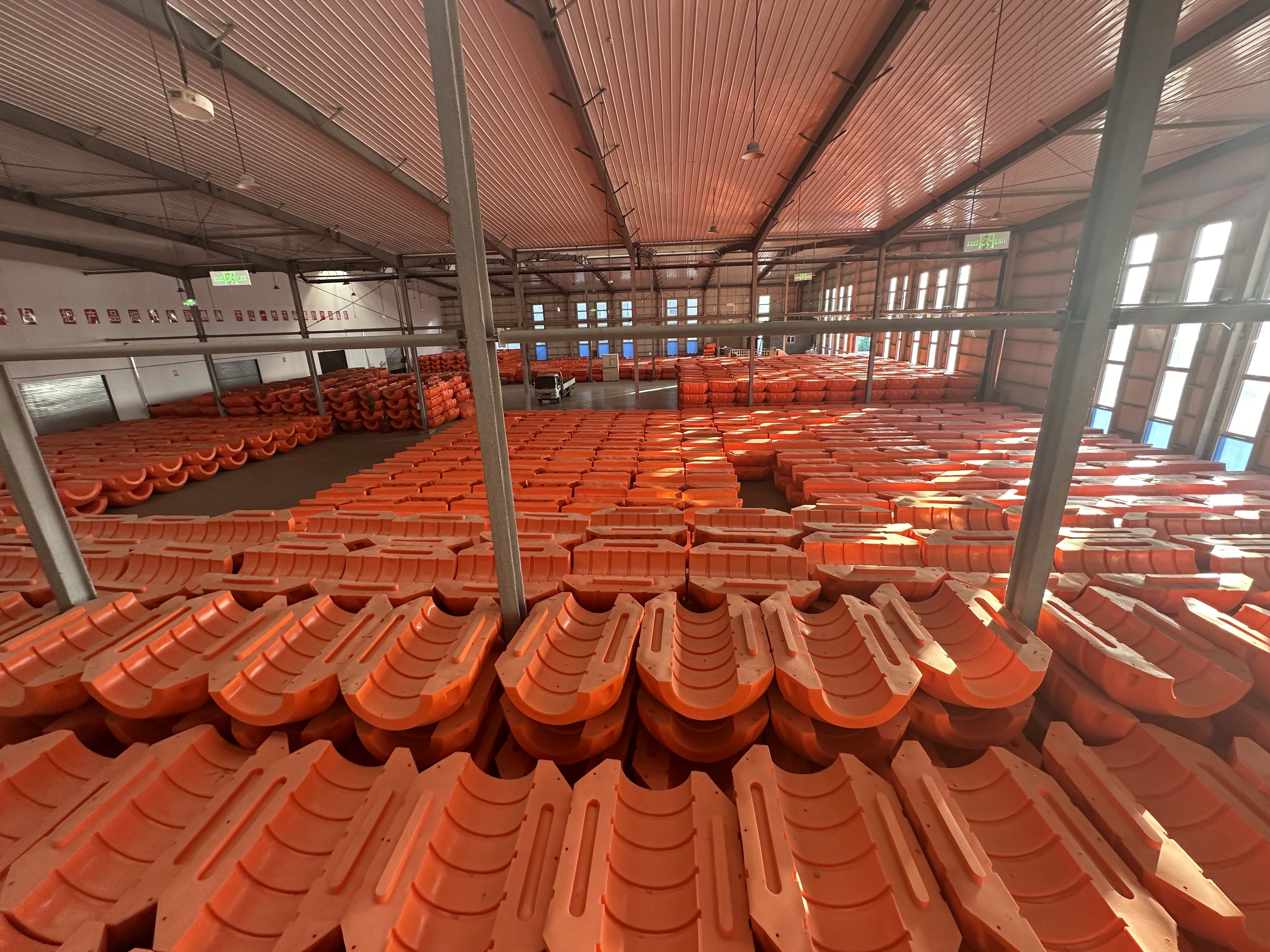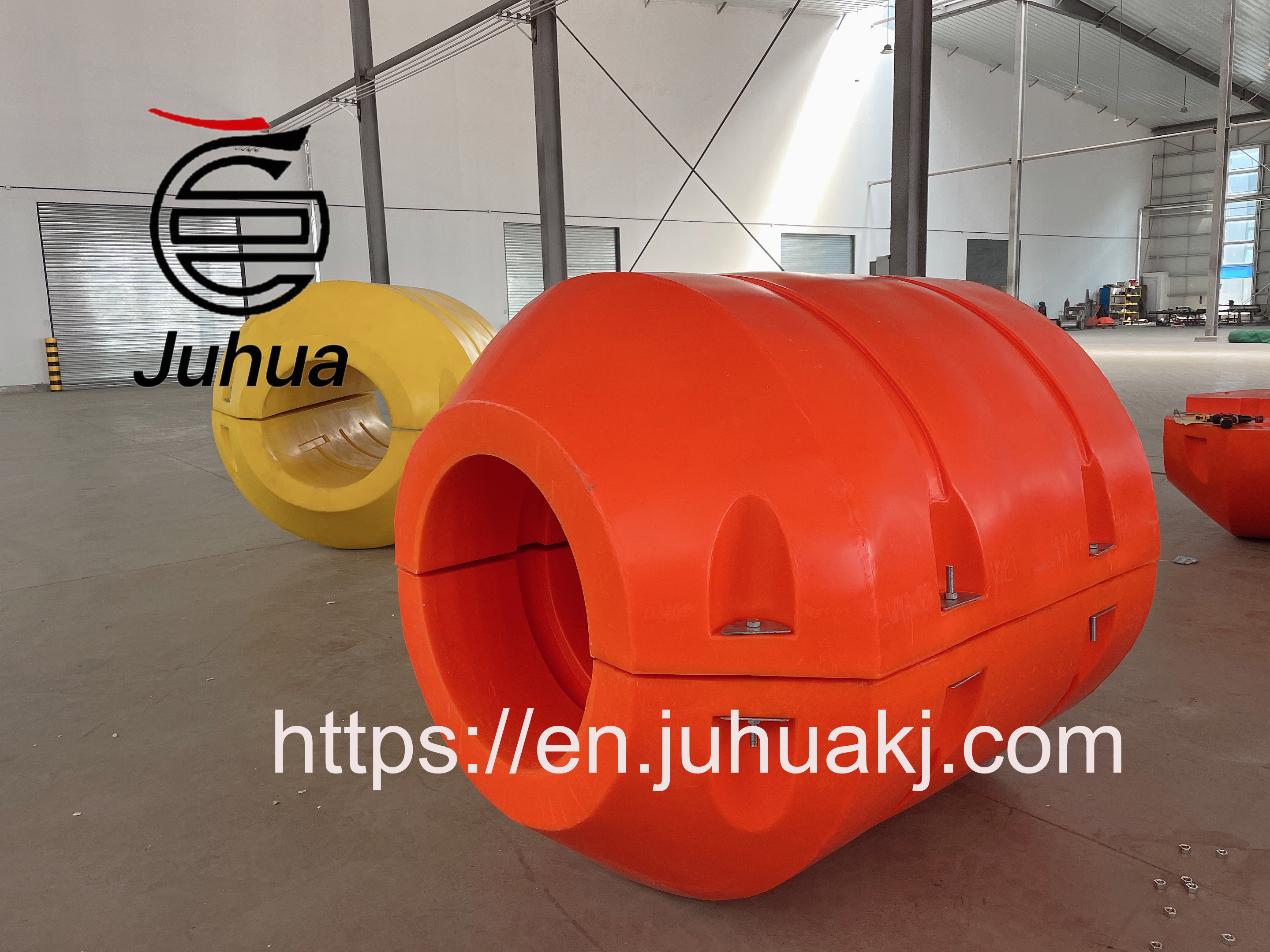Produce and export high quality dredging pipe float ,HDPE Floater
PRODUCT INTRODUCTION The pipe line float is one of the important components of the dredging project. The key factors for correctly selecting the floating body model include the arrangement and layout of the floating bodies, the composition of the conveying medium, the length of the pipeline, etc., so as to calculate the accurate floating body size and wall thickness, coupled with high-quality material selection and internal foam flling to ensure dredging Safe and reliable operation of pipelines. Main Specifications: project Shell performance index project Internal performance indicators Tensile Strength >12Mpa water absorption <2g/100c㎡ Elongation at break 10.1% Breaking strength 0.08-0.18Mpa Impact strength >31.4KJ/㎡ Elongation at break 4-6% Bending strength >15.7Mpa compressive strength 0.18-0.24Mpa specific gravity 0.93 heat resistant temperature -60°C-----+120°C Pipe Floats/Pipeline Floats Model ID (mm) OD (mm) L (mm) Thickness (mm) Buoyancy (kg) FT500*500 110 500 500 5 150 FT600*700 220/250 600 700 5 220 FT500*800 160/200 500 800 5 240 FT700*900 280 700 900 5 450 FT800*1000 315 800 1000 6 550 FT800*1100 400 800 1100 6 600 FT1000*1000 325/350 1000 1000 6 650 FT1100*1100 380/400 1100 1100 6 850 FT1200*1200 430/450/500 1200 1200 7 1200 FT1300*11300 480/500/560 1300 1300 7 1500 FT1300*1500 530/560/630/610/660 1300 1500 8 1700 FT1400*1500 560 1400 1500 8 1900 FT1300*1600 560 1300 1600 8 2000 FT1400*1600 630 1400 1600 8 2100 FT1500*1850 670/680/650/720 1500 1850 9 2560 FT1600*1900 730 1600 1900 9 2900 FT1700*2000 780/810 1700 2000 9 2900 TF1850*2100 840 1850 2100 10 3400 FT2000*2400 900 2000 2400 12 4800 FT2040*2500 940 2040 2500 13 5000 FT2400*2600 1150 2400 2600 14 6500 Rotomizing Process The Four Principal Stages of Rotational Moulding Rotoplastic molding, also known as rotary molding, is to load a quantitative powder resin into a cold mold. The mold is driven by a rolling machine to rotate and rotate slowly around two vertical rotating axes, while the mold is heated by an external heat source, so that the resin powder is melted and evenly coated on the surface of the entire mold cavity with its own gravity. Finally, the method of hollow product is obtained after cooling and demoulding. Compared with the extrusion, injection molding and blow molding processes often used in plastic molding, the rotoplastic process is more suitable for the production of large and medium-sized or complex plastic products, and the product has almost no internal stress and other advantages. Rotational Molding Process Characteristics 1. Low cost of rolling short mold: For products with the same specifications and sizes, the cost of rotoplastic mold is much lower than that of blow molding and injection molding. 2. The edge strength of rotoplastic products is good, and the thickness of the edge of the products is thicker. Solve the problem of thin edges of products in the middle room 3, rotomolding can be placed in various inlay 4, the shape of rotomolding products c
Category:
Products
Product Description
PRODUCT INTRODUCTION
The pipe line float is one of the important components of the dredging project. The key factors for correctly selecting the floating body model include the arrangement and layout of the floating bodies, the composition of the conveying
medium, the length of the pipeline, etc., so as to calculate the accurate floating body size and wall thickness, coupled with high-quality material selection and internal foam flling to ensure dredging Safe and reliable operation of pipelines.
Main Specifications:
|
project |
Shell performance index |
project |
Internal performance indicators |
|
Tensile Strength |
>12Mpa |
water absorption |
<2g/100c㎡ |
|
Elongation at break |
10.1% |
Breaking strength |
0.08-0.18Mpa |
|
Impact strength |
>31.4KJ/㎡ |
Elongation at break |
4-6% |
|
Bending strength |
>15.7Mpa |
compressive strength |
0.18-0.24Mpa |
|
specific gravity |
0.93 |
heat resistant temperature |
-60°C-----+120°C |
|
Pipe Floats/Pipeline Floats |
|||||
|
|
(mm) |
(mm) |
(mm) |
(mm) |
(kg) |
|
FT500*500 |
110 |
500 |
500 |
5 |
150 |
|
FT600*700 |
220/250 |
600 |
700 |
5 |
220 |
|
FT500*800 |
160/200 |
500 |
800 |
5 |
240 |
|
FT700*900 |
280 |
700 |
900 |
5 |
450 |
|
FT800*1000 |
315 |
800 |
1000 |
6 |
550 |
|
FT800*1100 |
400 |
800 |
1100 |
6 |
600 |
|
FT1000*1000 |
325/350 |
1000 |
1000 |
6 |
650 |
|
FT1100*1100 |
380/400 |
1100 |
1100 |
6 |
850 |
|
FT1200*1200 |
430/450/500 |
1200 |
1200 |
7 |
1200 |
|
FT1300*11300 |
480/500/560 |
1300 |
1300 |
7 |
1500 |
|
FT1300*1500 |
530/560/630/610/660 |
1300 |
1500 |
8 |
1700 |
|
FT1400*1500 |
560 |
1400 |
1500 |
8 |
1900 |
|
FT1300*1600 |
560 |
1300 |
1600 |
8 |
2000 |
|
FT1400*1600 |
630 |
1400 |
1600 |
8 |
2100 |
|
FT1500*1850 |
670/680/650/720 |
1500 |
1850 |
9 |
2560 |
|
FT1600*1900 |
730 |
1600 |
1900 |
9 |
2900 |
|
FT1700*2000 |
780/810 |
1700 |
2000 |
9 |
2900 |
|
TF1850*2100 |
840 |
1850 |
2100 |
10 |
3400 |
|
FT2000*2400 |
900 |
2000 |
2400 |
12 |
4800 |
|
FT2040*2500 |
940 |
2040 |
2500 |
13 |
5000 |
|
FT2400*2600 |
1150 |
2400 |
2600 |
14 |
6500 |
Rotomizing Process
The Four Principal Stages of Rotational Moulding

Rotoplastic molding, also known as rotary molding, is to load a quantitative powder resin into a cold mold. The mold is driven by a rolling machine to rotate and rotate slowly around two vertical rotating axes, while the mold is heated by an external heat source, so that the resin powder is melted and evenly coated on the surface of the entire mold cavity with its own gravity. Finally, the method of hollow product is obtained after cooling and demoulding. Compared with the extrusion, injection molding and blow molding processes often used in plastic molding, the rotoplastic process is more suitable for the production of large and medium-sized or complex plastic products, and the product has almost no internal stress and other advantages.
Rotational Molding Process Characteristics
1. Low cost of rolling short mold: For products with the same specifications and sizes, the cost of rotoplastic mold is much lower than that of blow molding and injection molding.
2. The edge strength of rotoplastic products is good, and the thickness of the edge of the products is thicker. Solve the problem of thin edges of products in the middle room
3, rotomolding can be placed in various inlay
4, the shape of rotomolding products can be complex
5, Rotomolding products can be produced fully closed products
6, rotomolding products can be filled with foam materials to achieve insulation
7, no need to adjust the mold, the wall thickness of rotomolding products can be freely adjusted
Rotomized Material
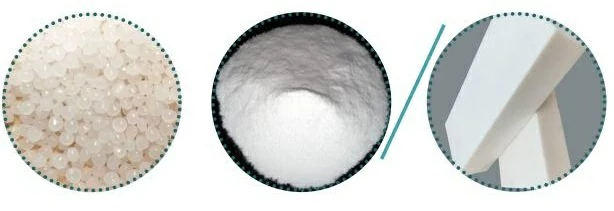
Linear low density polyethylene (LDPE)resin is called the third generation polyethylene.In addition to the properties of general
polyolefin resins, its tensile strength, tearstrength, environmental stress crack resistance,low temperature resistance, heat resistance The performance and puncture resistance areparticularly superior.
The characteristics of polyurethane foam itself: light weight, heat insulation, heatpreservation, waterproof, fire and corrosion resistance, abrasion resistance, oil resistance, fatigue resistance, vibration resistance andstrong adhesion.

Shell Material
Linear low density polyethylene (LIDPE) resin is called the third generation polyethylene. In addition to the properties of general polyolefin resins, its tensile strength, tear strength, environmental stress crack resistance, low temperature resistance, heat resistance The performance and puncture resistance are particularly superior.
Inner Filler
The characteristics of polyurethane foam itself: light weight, heat insulation, heat preservation, waterproof, fire and corrosion resistance, abrasion resistance, oil resistance, fatigue resistance, vibration resistance and strong adhesion.
Rotational molding is to first add plastic raw materials into the mold, and then the mold is continuously rotated along two vertical axes and heated, so that the plastic raw materials in the mold are gradually uniformly coated and melted and adhered to the mold under the action of gravity and thermal energy. The entire surface of the cavity is formed into the desired shape, then cooled to shape, demolded, and finally the product is obtained.

Product Installation


Put any piece of floating body arc face down and put the HDPE pipe on the floating body. Then take any piece of floating body and buckle it on the pipe. Fix it with gaskets and bolts. Align the flange hole of the rubber hose with that of the HDPE pipe, pass the bolt through the flange hole, and tighten the nut to fix it.

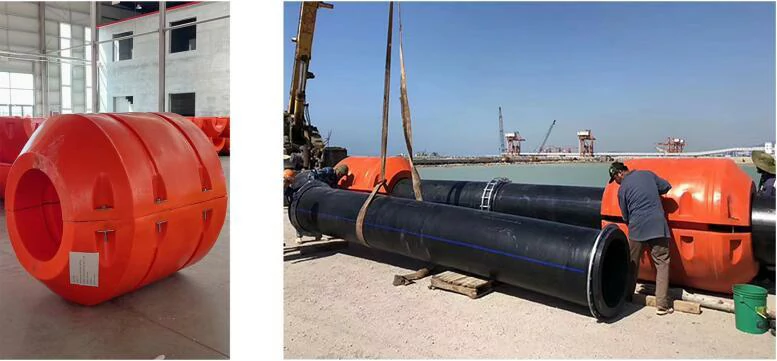
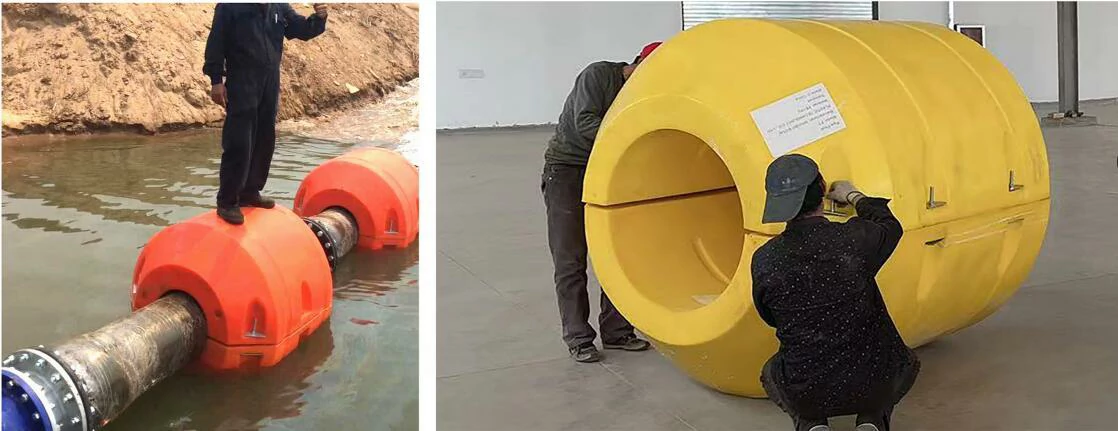
PRODUCT CERTIFICATION

Delivery Loading
Online message
Related Products





